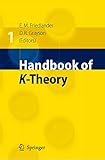Handbook of K-Theory / edited by Eric M. Friedlander, Daniel R. Grayson.
Tipo de material: TextoEditor: Berlin, Heidelberg : Springer Berlin Heidelberg, 2005Descripción: eReference recurso en líneaTipo de contenido:
TextoEditor: Berlin, Heidelberg : Springer Berlin Heidelberg, 2005Descripción: eReference recurso en líneaTipo de contenido: - texto
- computadora
- recurso en línea
- 9783540278559
- QA612.33
Springer eBooks
Part I: Foundations and Computations: Deloopings in Algebraic K- theory -- The Motivic Spectral Sequence -- K-theory of truncated polynomial algebras -- Bott Periodicity in Topological, Algebraic and Hermitian K-theory -- Algebraic K-theory of Rings and Integers in Local and Global Fields. Part II: K-theory and Algebraic Geometry: Motivic Cohomology, K-theory and topological cyclic Homology -- K-theory and Intersection Theory -- Regulators -- Algebraic K-theory, Algebraic Cycles and Arithmetic Geometry -- Mixed Motives. Part III: K-theory and Geometric Topology: Witt Groups -- K-theory and Geometric Topology -- Quadratic K-theory and Geometric Topology. Part IV: K-theory and Operator Algebras: Bivariant K-and Cyclic Theories -- The Baum-Connes and the Farrell-Jones Conjectures in K-and L-theory -- Comparison Between Algebraic and Topological K-theory for Banach Algebras and C*-Algebras. Part V: Other Forms of K-theory: Semi-topological K-theory -- Equivariant K-theory -- K(1)-local Homotopy Theory, Iwasawa Theory and Algebraic K-theory -- The K-theory of Triangulated Categories.
This handbook offers a compilation of techniques and results in K-theory. These two volumes consist of chapters, each of which is dedicated to a specific topic and is written by a leading expert. Many chapters present historical background; some present previously unpublished results, whereas some present the first expository account of a topic; many discuss future directions as well as open problems. The overall intent of this handbook is to offer the interested reader an exposition of our current state of knowledge as well as an implicit blueprint for future research. This handbook should be especially useful for students wishing to obtain an overview of K-theory and for mathematicians interested in pursuing challenges in this rapidly expanding field.
Para consulta fuera de la UANL se requiere clave de acceso remoto.


